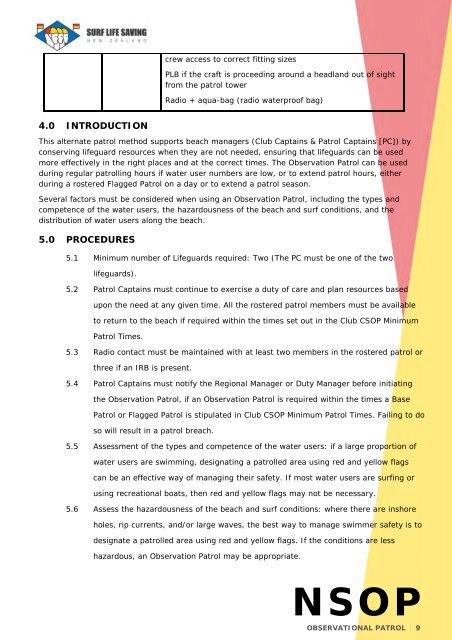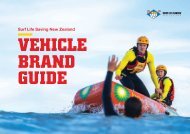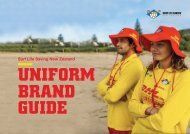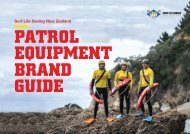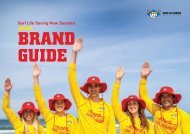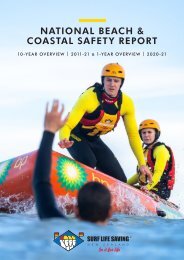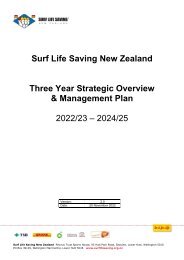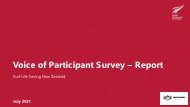National Standard Operating Procedures - Jul 2022
Full NSOP Manual
Full NSOP Manual
You also want an ePaper? Increase the reach of your titles
YUMPU automatically turns print PDFs into web optimized ePapers that Google loves.
crew access to correct fitting sizes<br />
PLB if the craft is proceeding around a headland out of sight<br />
from the patrol tower<br />
Radio + aqua-bag (radio waterproof bag)<br />
4.0 INTRODUCTION<br />
This alternate patrol method supports beach managers (Club Captains & Patrol Captains [PC]) by<br />
conserving lifeguard resources when they are not needed, ensuring that lifeguards can be used<br />
more effectively in the right places and at the correct times. The Observation Patrol can be used<br />
during regular patrolling hours if water user numbers are low, or to extend patrol hours, either<br />
during a rostered Flagged Patrol on a day or to extend a patrol season.<br />
Several factors must be considered when using an Observation Patrol, including the types and<br />
competence of the water users, the hazardousness of the beach and surf conditions, and the<br />
distribution of water users along the beach.<br />
5.0 PROCEDURES<br />
5.1 Minimum number of Lifeguards required: Two (The PC must be one of the two<br />
lifeguards).<br />
5.2 Patrol Captains must continue to exercise a duty of care and plan resources based<br />
upon the need at any given time. All the rostered patrol members must be available<br />
to return to the beach if required within the times set out in the Club CSOP Minimum<br />
Patrol Times.<br />
5.3 Radio contact must be maintained with at least two members in the rostered patrol or<br />
three if an IRB is present.<br />
5.4 Patrol Captains must notify the Regional Manager or Duty Manager before initiating<br />
the Observation Patrol, if an Observation Patrol is required within the times a Base<br />
Patrol or Flagged Patrol is stipulated in Club CSOP Minimum Patrol Times. Failing to do<br />
so will result in a patrol breach.<br />
5.5 Assessment of the types and competence of the water users: if a large proportion of<br />
water users are swimming, designating a patrolled area using red and yellow flags<br />
can be an effective way of managing their safety. If most water users are surfing or<br />
using recreational boats, then red and yellow flags may not be necessary.<br />
5.6 Assess the hazardousness of the beach and surf conditions: where there are inshore<br />
holes, rip currents, and/or large waves, the best way to manage swimmer safety is to<br />
designate a patrolled area using red and yellow flags. If the conditions are less<br />
hazardous, an Observation Patrol may be appropriate.<br />
NSOP<br />
OBSERVATIONAL PATROL 9


